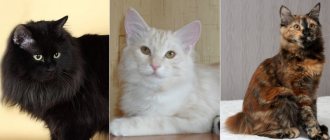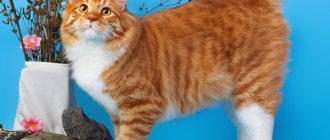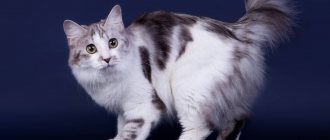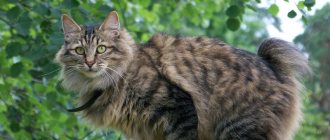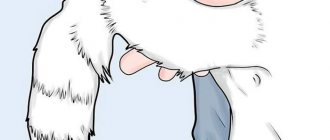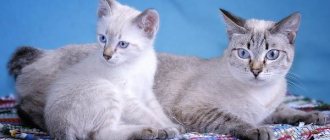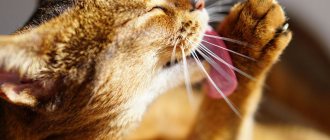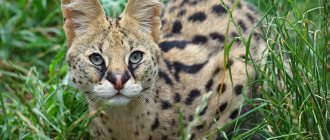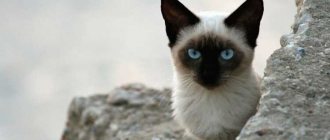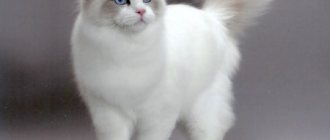The Kurilian Bobtail is an interesting representative of the cat family. Due to its size and habits, it has taken root well in rural areas. It’s difficult to call her sweet and gentle; many of her character traits suggest that she is a dog in cat’s clothing. You shouldn’t make a fuss towards the bobtail; you’ll be ignored – call him by name.
Such habits are sure to endear dog lovers who do not like the amount of attention that a dog usually needs. Of course, a cat can be raised to be affectionate and gentle, but it is difficult to perceive the Kuril Bobtail as a sissy.
The Soviet Union is considered the birthplace of the breed - it was thanks to Soviet felinologists that the cat came to the mainland and received recognition. At the same time, there is reason to believe that the breed is more than 200 years old, and it originated, then, on the Japanese islands.
History of the origin of the breed
The Kuril Islands (namely the southern part of the archipelago) are a stumbling block between two powers: Japan and Russia. And we are talking here not only about territory, but also about the rights to this miracle cat.
Most felinologists believe that Kuril bobtails descended from short-tailed cats that lived on the archipelago at least since the 18th century.
Their ancestors were supposedly wild cats, and they themselves appeared as a result of the union of Japanese bobtails and Siberian cats.
Ancient beliefs of the Land of the Rising Sun say that Japanese bobtails were considered a symbol of good luck and therefore were overly patronized by local residents. They came to the island along with Japanese traders, military personnel and as part of various expeditions. Cats often ran away from their owners into the wild, as happens now.
As for Siberian cats, they came to the Kuril Islands along with settlers.
The animals quickly found a common language, and as a result of this union, a new breed arose, which now bears the proud name of the Kurilian Bobtail. The local population did not immediately notice the new breed and for a long time considered them to be ordinary Japanese bobtails.
Kurilian bobtails have existed as a separate species for more than 200 years. By the way, cats of this breed are often confused with the similar-looking Karelian Bobtail, both in the description of the breed and in the history of its origin. It is worth noting that they are not genetically related, but only externally similar.
Tatyana Bocharova and Liliya Ivanova, observing the selection of cats, came to the conclusion that a short tail is inherited by all animals, which meant the absence of any anomalies in their development.
It was the contribution of Soviet scientists that contributed to the recognition and popularization of the Kuril Bobtail. The first breed standard was adopted by the Soviet Felinological Federation (SFF) in October 1991, the latest international standard in 2001. This breed was recognized by international felinological organizations in 1994.
It was thanks to the proposal of Russian breeders at the 1994 seminar, and the increased interest of European representatives, that 3 years later the breed received recognition from the international organization WCF. Later, the breed was recognized by the associations TICA and FIFe as independent, but at the same time they do not have the opportunity to obtain champion status at exhibitions.
Description, what it looks like, what colors there are
The appearance and bright colors of the Bobtail immediately attracts attention. These cats have well-developed muscles, stockiness and a strong build.
Sexual dimorphism in representatives of the breed is pronounced - cats are much larger than cats. The fact that Kurils have wild roots is clearly visible in their appearance, both in long-haired and short-haired varieties.
Black
The color can be either completely black or with a small splash of white hair on the chest and ends of the paws. In old age, Kurils with this color may develop a brown tint.
Black and white color
Black marble
This color is inherited from the wild ancestors of Bobtails and gives the cat a particularly impressive appearance. This color belongs to the tabby color and is most often found among Kurbobs.
Black and white
Black and white is quite varied. It can be a basic black color interspersed with white, randomly located. Another option is a white base interspersed with black. Black and white striped color is very rare.
White
Solid color, in which a blue iris is allowed. The long-haired representatives of the breed look especially impressive.
Ginger
Available in solid or tabby color. The category of redheads includes red and cream colors. The presence of white inclusions is allowed.
Grey
Solid and tabby colors are possible. The presence of inclusions of white wool is allowed. Blue colors also fall into this category.
Tortoiseshell
Kurbobs have tortoiseshell colors according to the standard, only black and blue are possible. In black suit with this type of color there are inclusions of brown, red and white wool, with a predominance of dark tones. The blue color combines light and dark wool of a silver-gray, bluish color. This option is less common and looks especially impressive.
Character of the Kurilian Bobtail
Haxie in a cat's body - this description best describes the Kuril cat for those who are familiar with dogs. It’s hard not to draw parallels between this cat and dogs, just as, for example, it’s hard not to compare a Yorkie to a cat.
Kuril is devoted to his owner, as well as to his family as a whole, capable of following commands and even protecting the family hearth from dogs. True, in order for him to recognize you as the owner, you need to show and demonstrate your character - this is precisely the trait in him that resembles a husky.
Also, Kurilian Bobtails require attention - and we are not talking here about endless stroking, but about walks and discipline. The Bobtail is physically well developed and requires a lot of activity throughout the day to maintain good spirit and health. It is unlikely to take root in an apartment - there is little space for walking, and little fresh air.
Tolley's business is at home - go fishing or mushroom picking with the owner. The Kurilian Bobtail is not afraid of water and even loves to swim. Even if you don’t get a bite, the cat can give away its catch, or its remains. If the conditions necessary for it are not created, or if it is treated as a piece of furniture, the Kurilian Bobtail will begin to damage the furniture and mark its territory. Yes - this is an expression of protest, from which it will be difficult to wean him later.
If you decide to give the cat to someone else, it will take time, of course, but the smoker will be able to get used to the change of owner. Despite its formidable appearance, the bobtail is inquisitive and affectionate towards guests, children and other animals. Of course, this does not apply to much smaller animals that may become part of its diet - birds, mice and even guinea pigs are at risk.
The cat is very smart, easy to train and responds to its name. We don’t like a lot of attention and affection, of course he doesn’t refuse, but with too much persistence he will start grumbling or run away from the sofa. The instinct of a predator and a free animal in the Kuril Bobtail, although dulled, is still present. You cannot leave him unattended and unattended - he will eventually run away and run wild.
Choosing a kitten
Even before going to the breeder, you need to decide what kind of kitten you need: a pet, a show star or a stud? Then you need to decide what gender the animal should be. Toys, a tray with filling and a supply of food for the first time must be prepared in advance.
You can go to the “browse” when the kittens are 5 weeks old. But it is not recommended to take a baby into the home under 8 weeks of age.
At the breeder, pay attention to the conditions of detention. There should be no strong odor of urine, dirty bowls or overcrowding of animals
The kitten must be:
- active, playful;
- not cowardly, curious and sociable;
- eyes and nose are dry, without discharge;
- the anus is not inflamed, without traces of feces;
- the stomach is soft, not bloated;
- the coat is clean and shiny.
The normal weight of a kitten at 2 months of age is 1 – 1.5 kg. He should not look emaciated or, on the contrary, too large.
Care and maintenance
The Kurilian Bobtail is a fairly independent cat breed that is very easy to care for and does not require much attention. Of course, you shouldn’t leave the cat to its own devices, but you won’t have to worry too much about it.
Like any other pet, a cat of this breed needs proper nutrition, attention to health, and a little attention and affection. Kuril needs training and physical activity. You may not want him to follow fetch, lie, place commands (although he can), but going to the right place to go to the bathroom and not damaging the furniture is common sense and a necessity.
One of the possible inconveniences is walking. Cat owners usually do not think about this problem, because almost all cats do not need this and an apartment and a balcony are enough for them. With the Kurilian Bobtail everything is more complicated - regular walks on a leash in the park or street are necessary. This is not an exotic couch potato, but a mighty cat that you need to walk with even in winter.
Previously wild animals need vaccination against diseases and rabies. After all, not only on walks on the street with you can a smoker catch an infection, but also from your outerwear. For the same reason, your cat needs to be periodically dewormed.
Bathing
Bathing is a process that can bring you significantly closer to the Kurilian Bobtail. As mentioned earlier, he is not afraid of water and loves it. But this in no way means that he will happily accept being forced to perform water procedures.
There is no need to bathe frequently, 2-3 times a year and after active walks, when there is no choice left. Depending on the length of the coat (and the Kurilian Bobtail can be short-haired or long-haired), you can use shampoos and conditioners, and after bathing you can get by with a towel or, in the case of long-haired cats, you need to use a hair dryer. The cat should be completely dry; it is easier and safer to spend more energy drying it than to then treat a cold.
Frequent water scrubbing is not only bad for your cat's grumbling, but can also be bad for his skin and coat. Regular licking keeps her reasonably clean and provides adequate hygiene in most cases.
Nutrition
The Kurilian Bobtail is a large and recently domesticated animal. These factors greatly affected the cat's diet. The nutrition they require is not much different from a mongrel or most cats. And if it differs, it is primarily in quantity.
It is important that the diet is balanced, and the Kuril cat receives a sufficient amount of microelements and vitamins, but the sources are not so important. Still, they prefer to provide bobtails with natural food:
- raw meat and fish - from 60% of all food. Of course, lean meat is better - turkey, rabbit, chicken and beef. The meat itself needs to be disinfected - frozen for a day, and then filled with warm water and, after defrosting, served to the cat;
- Vegetables, porridge and dairy products are also necessary for the cat, even if she tries to ignore them. You can trick your pet by mixing meat with boiled porridge - then he will eat everything. There is an opinion that you should not give potatoes and milk to a bobtail, but this applies to individual cases and the age of the cat. If you need the ideal diet specifically for your cat, contact your veterinarian. He will take into account the smoker’s lifestyle, weight, gender and age and create the correct diet for your pet.
The serving size is calculated based on the weight of the pet - 33 grams of food per 1 kg of cat weight. An adult cat needs to be fed 2-3 times a day, kittens more often. They will not leave themselves hungry and will remind you of themselves and their discontent. Some owners give various food additives for cleaning teeth, and additional vitamins. Many people also do not disdain cat grass, but if the cat walks enough, there is no need for this.
The cat should always have clean water and there should be enough of it.
The hunter at heart may find his own live food from time to time, and that's part of the problem. Worms and infections are possible consequences in a former feral cat.
Dry food is given no earlier than 3 months, but there is no need to mix different diets or change them frequently. This will be bad for your cat's health. In addition, when cleaning the cat's litter box, you need to check the stool - it should not be excessively liquid or dry. This may indicate an incorrectly selected or poorly balanced diet. You also need to check for worms in the stool and traces of blood.
Health
Bobtails are distinguished by good health and endurance. They are not prone to colds, they have virtually no genetically determined diseases. Average life expectancy is 17 years.
But animals may have difficulty defecating, inflammation of the anus, and if left untreated, rectal prolapse may occur. To prevent hemorrhoids, examine the kitten’s butt daily and monitor its stool. If redness, inflammation, cracks, or crusts appear, contact a veterinarian.
Treatment will not give results without revising the animal’s diet.
Deworming courses are also part of the prevention of hemorrhoids and related problems.
Wearing a special collar will prevent the animal from becoming infected with fleas and ticks.
Representatives of the breed are prone to the appearance of kidney stones (acid type). This is due to the higher urine pH levels in these cats (7 – 7.5).
Kuril residents are vaccinated against plague and other infectious diseases annually. Then they get vaccinated against rabies. Revaccination is carried out after 12-18 months.
